Revitalize your living space with these trendy and durable window treatments for your sliding doors.
Window treatments and shades for your sliding glass doors will do more than just look good — they’ll control light, insulate your home and show off your creativity. Whether you’re going for streamlined minimalism or snug texture, the right treatment will marry form and function seamlessly. Read on to discover some of the best contemporary curtain options for sliding glass doors, including different styles, materials and operating mechanisms.
Subtle Sliding Glass Door Roller Shades

Credit: the shade store
If you’d like a clean look without the burden of lots of fabric, roller shades are a sleek, understated option. When they’re raised, they all but disappear into a subtle top cassette, preserving the openness of your space.
If maintaining a clear view to the outside during the day is a priority, then light-filtering fabric is your best choice. Opt for motorized or corded roller shades based on your budget and lifestyle requirements.
Insulated Drapes for Sliding Doors
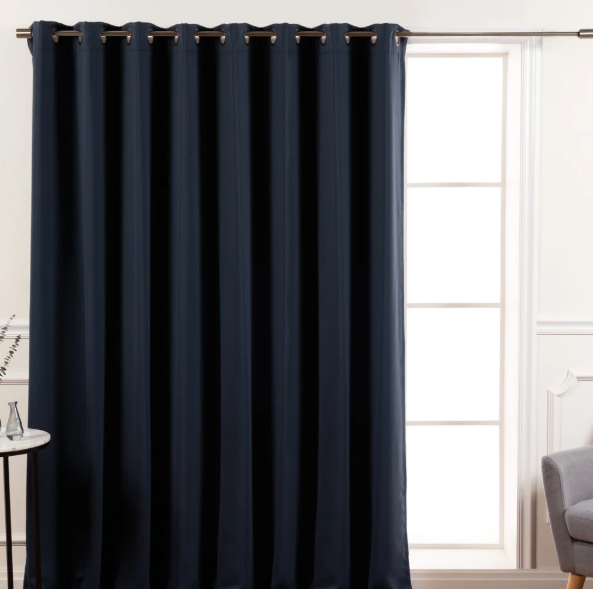
Credit: way fair
Doors that are south or west facing can invite high heat and glare. Thick blackout curtains with thermal lining are great for regulating your room’s temperature and blocking out UV rays that can damage your floor and furniture.
For more control, try double-layered curtains — sheer during the day, with a blackout layer at night. This duo allows filtered light to enter your home without sacrificing privacy or energy efficiency.
Related: https://www.windowscover.com/custom-s-fold-curtains.html
Curtain with Magnetic Tie Backs
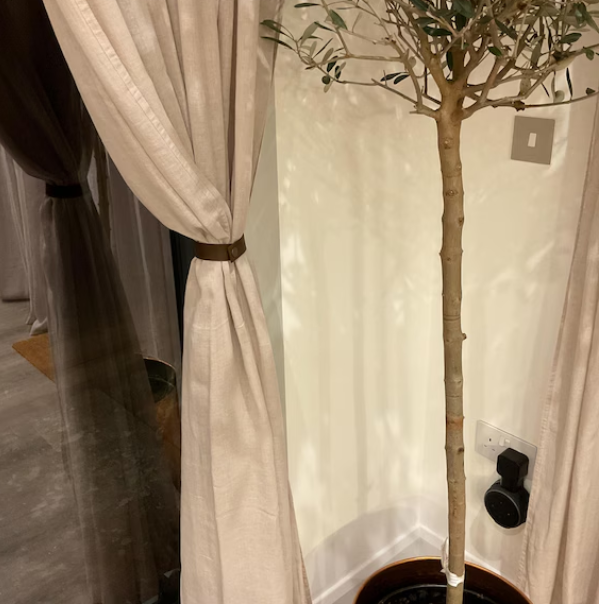
Credit: etsy
Sliding doors are used often, so choosing a window treatment that allows for easy operation of the door is necessary. Opt for tiebacks, magnetic hold backs or even panel track curtains that slide out of the way with a hip.
Also, be mindful of curtain lengths: you want panels to dance just above the floor to keep dirt at bay and eliminate any dragging. Choose grommet-top or ring-top styles as an added convenience, since they glide effortlessly on the rod.
Decorative Window Treatments

Credit: country living
And sometimes curtains are just for looks. Drapery Panels Framing a sliding glass door with drapery panels introduces warmth, softness and color without obscuring the view when closed.
For a polished feel, choose fabric that echoes your room’s palette and feels like linen or jacquard. If your privacy isn’t an issue, stationary panels on either side of the door contribute visual symmetry without sacrificing function.
Extra Long Thick Linen Curtains
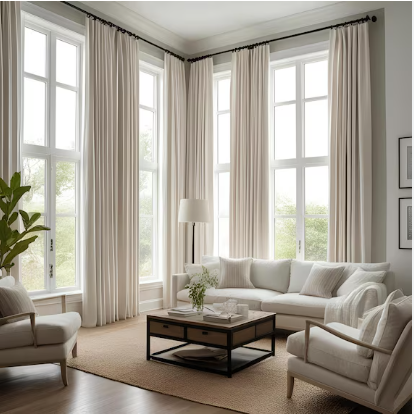
Credit: etsy
To ensure your curtains don’t hinder traffic, put up a curtain rod that is wider than the door. This permits the panels to be pushed aside without obstructing the opening.
Thicker materials — think velvet or polyester blends — offer excellent light control, while lighter ones, such as cotton or sheer voile, impart a more casual, airy vibe.
Coordinated Look for Sliding Doors and Adjacent Windows
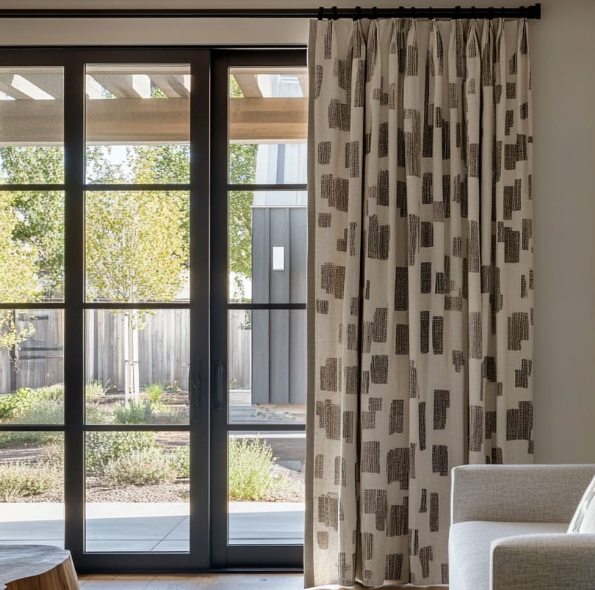
Credit: fancy house design
If your sliding glass doors next to the standard windows, treat them as a unified space. Matching drapes, continuous curtain rod Creates a unified look as regular pocket style curtain will always gap in the middle.
Opt for neutral colors to create a cohesive backdrop, or mix fabrics for added depth — like linen curtains with a bamboo shade in the window for a layered, designer finish.
Classic and Custom Made Vertical Blinds
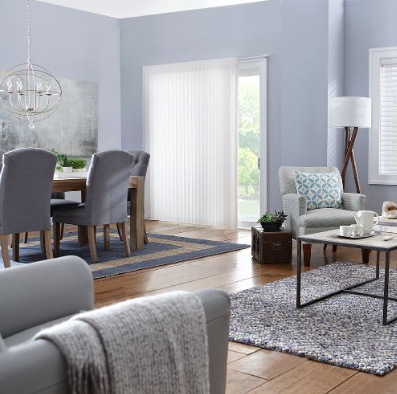
Credit: budget blinds
Today’s vertical blinds remains a favourite for sliding glass doors due to its anti-cord feature, broad panel capability and the simplicity in both design and function. They are available in PVC, fabric or faux wood to complement different décor styles in a room.
Unlike regular curtains, you can adjust the angle of the slats to block sun without entirely pulling them open. Opt for cordless wand control for the utmost in child safety and everyday ease of use.
Modern Panel Track Blinds for a Modern Look
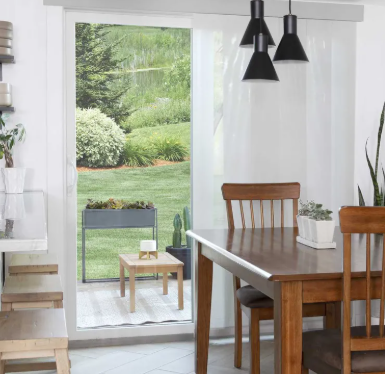
Credit: select blinds
Panel track shades put a modern spin on vertical blinds. Each panel travels on its own track, for a clean and contemporary look open or closed.
For a wider door span, they come in textured fabrics, solar materials or a woven wood to complement modern and rustic home interiors. For a customized look, pair with a valance.
Roman Blinds with Sheer Curtains for Soft Natural Light
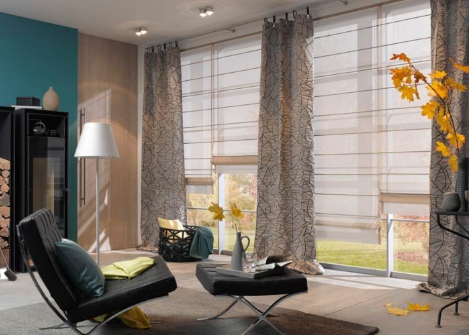
Credit: net curtains direct
If you want to let the sun light in but filter it a bit, sheer curtains are a classic. They provide light in and daytime privacy.
For even more function, layer them with heavier, blackout curtains or roman shades. This two-layer configuration puts you in full charge of your light during the day.
Cellular Shades with Vertical Pleats
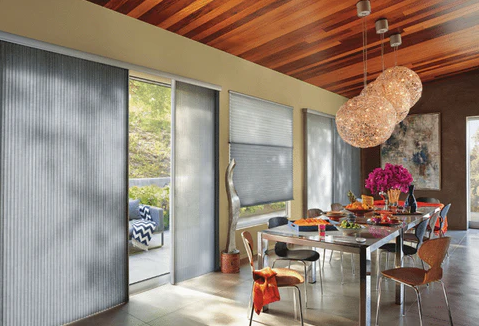
Credit: avalon flooring
Vertical cellular shades are the perfect balance of energy efficiency and light-filtering elegance. The honeycomb design catches air which provides insulation in the heat of summer and the cold of winter.
They are particularly valuable in minimalist environments where you desire clear lines and minimal visual noise. Opt for cordless or remote-operated styles for convenience and safety.
Sliding Glass Door Roman Shades for a Soft Classic Look
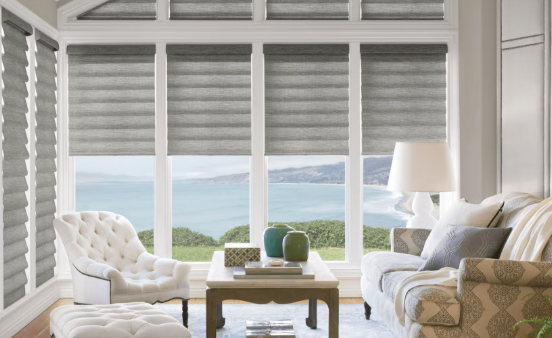
Credit: hunter douglas
Roman shades can be used on sliding doors by installing them on rails so they move horizontally. These are ideal for traditional or transitional decor.
Depending on your privacy needs, opt for light-filtering fabrics or blackout linings. They come in cordless versions for added safety and easy operation.
Bamboo Shades for Sliding Doors
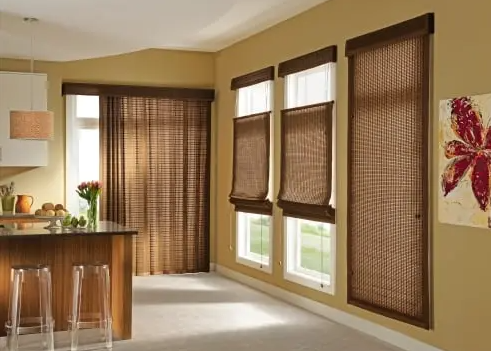
Credit: Map Quest
Shades in woven wood or bamboo panel let natural texture, warmth and an organic look. With a delightful light-filtration texture that’ll appear lovely next to boho, rustic or coastal interior design.
Choose top-down bottom-up control or pair with blackout liners for more privacy. The natural colors complement any neutral or color interior.
Related: https://www.windowscover.com/13-top-reasons-for-using-bamboo-blinds-in-your-home.html
Double Layer Curtains
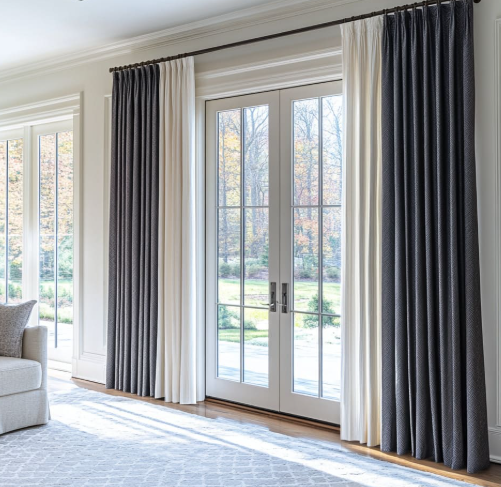
Credit: fancy house design
Use in combination with sheer and opaque curtains for a very chic layered look. Allow filtered light in during the day with a sheer layer. At night shut the heavier curtain for privacy and insulation.
You can hang both layers from a double curtain rod or take your boudoir to the next level with motorized dual-track system. This is good for bedrooms, living rooms and shared areas.
Cordless Blackout Zebra Curtains
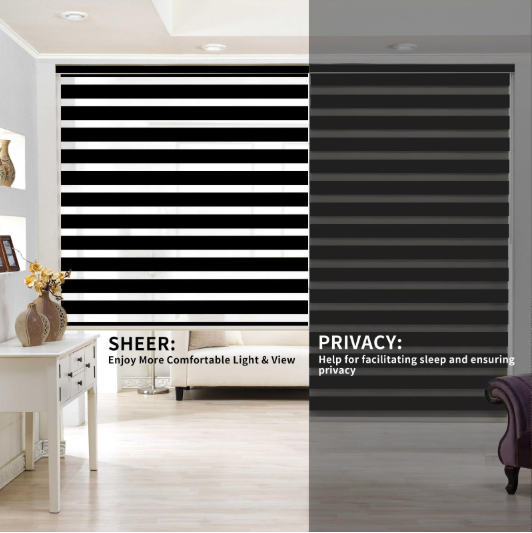
Credit: Amazon
Cordless curtains are perfect for homes with children and pets. These shades do not have loose cords and provide spring-loaded and motorized control.
You end up with a cleaner look, and the comfort of knowing the system is safe and easy to use. They tend to come in both standard and custom sizes.
Light Filtering Solar Screen Shades
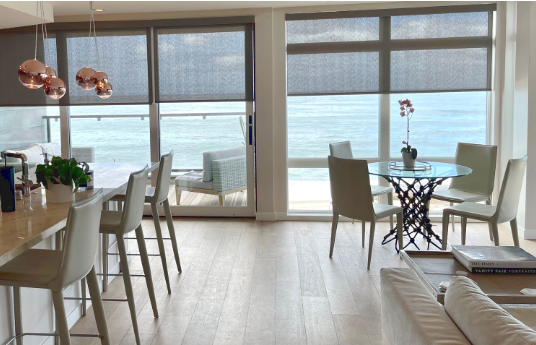
Credit: Stone side
Ideal for your living room light control, the light filtering solar shades offer an optimal energy efficiency and can lessen heating and cooling expenses by 25 percent. Not only do they keep light from streaming in, but they can also help diminish outside noise and prevent energy loss.
Smart Shades with Remote or App Control
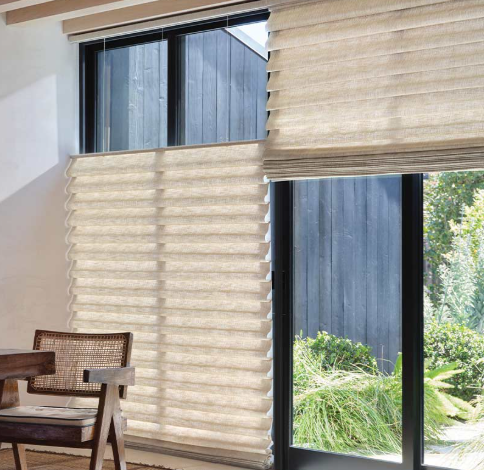
Credit: Austin Window Fashions
Automated sliding door shades that add luxury to your project and comfort to your life. Control them via a remote, smartphone or voice assistant, such as Alexa or Google Home.
Smart shades are awesome if you have windows and doors that are hard to reach or if you want to automate opening the shades for the day or closing the shades at sunset.
Mix & Match for Custom Styling
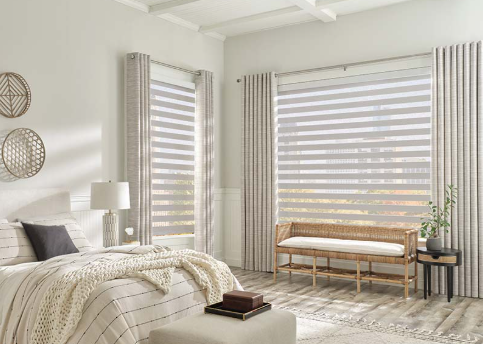
Credit: Skyline Window Coverings
And don’t feel limited to one treatment. Mix materials and mechanisms — consider motorized sheer zebra blinds combined with blackout curtain — for tailored function and layered style.
This mix-and-match style of designing means you can customize each treatment to suit your room’s lighting, privacy and decorating needs. It also adds a designer vibe to your sliding door space, no full renovation necessary.
FAQs
Q: What Curtain Length Works Best for Sliding Glass Doors?
A: Most sliding glass doors are approximately 80 inches tall, curtains typically cover about 84 inches of height. For a more formal, taller space, you can opt for 96-inch, or even 108-inch, curtains and position the rod higher above the frame. Just make certain the bottom of the skirt isn’t dragging so much unless you’re actually aiming for a “puddle” look.
Q: How Wide Should My Curtain Rod Be for Sliding Doors?
A: The curtain rods need to be wide enough to extend beyond your sliding door. A telescoping pole that expands from 66 to 120 inches accommodates most setups. Try to allow for a minimum of 10–12 inches of space on both sides of the door so the panels can stack back fully without obstructing the view or access.
Q: What’s the Best Way to Install Curtains Over Sliding Glass Doors?
A: Install your curtain rod anywhere from 4 to 8 inches above that frame. If there’s room height to spare, a higher application visually stretches the room. Make sure you use strong brackets and good hardware — because sliding door curtains tend to be heavier and get more use than curtains for windows. If you have walls made of concrete or tile, go with anchors or expansion bolts for added stability.
Q: Which Window Coverings Are Ideal for Sliding Glass Doors?
A: If you’re going for something that has a smallish footprint and does the trick, vertical blinds or panel track shades are your best bet—they glide easily and don’t require much side clearance. Blackout drapes or dual-layer curtains (sheer + opaque) provide a softer, cozier look with more flexibility in adjusting light and privacy.
Q: How Do I Maintain Privacy While Still Letting in Light?
A: Consider layered solutions such as pairing sheer panels with room-darkening or blackout drapes. Another clever choice: top-down bottom-up shades, which can be opened on the top for sunlight but remain closed on the bottom for privacy — perfect for patios or balconies that face the street.
Q: How Should I Choose the Right Treatment for My Sliding Glass Doors?
A: If it’s a high-traffic exit to your patio, yard or balcony, opt for treatments that slide without much resistance and don’t bunch or catch on anything. If it’s more decorative than practical, though, you can opt for looks over performance, like a woven wood shade or a linen curtain. Don’t forget insulation, child safety (cordless) and whether you want it to be operated manually or by a motor.
Q: Can I Use a Double Curtain Setup for Sliding Glass Doors?
A: Absolutely. So a double curtain setup, like sheer curtains plus blackout drapes, is a chic and practical pick. The sheer layer allows soft natural light through during the day while providing privacy, and the heavier layer blocks it out completely at night or when you need to keep out the sun.
Q: What’s the difference between day and night use with layered curtains?
A: Sheer curtains in the day will soften direct sunlight and maintain your space’s brightness and airiness. They also create privacy by obscuring outside views without making the room feel walled off. In the evenings, close the blackout or heavier fabric layer for full privacy and excellent insulation value.
Q: What’s the difference between light filtering, room darkening, and blackout curtains?
A: Light filtering curtains allow natural light to filter in while reducing glare. Room darkening curtains block out even more light —about 85–99%, they are ideal for bedrooms. Blackout curtains are as advertised: They block nearly 100% of light. Perfect for anyone who needs a pitch-black sleeping environment, day and night.
Q: Motorized vs. Corded vs. Cordless Curtains
A: Motorized blinds and curtains are operated by remote, wall switch or phone app. They’re great for hard-to-reach sliding glass doors, a wall of windows or homes equipped with smart technology. Corded window coverings rely on cords or chains to operate. They’re often the cheapest and provide fine control. Cordless models are easy to operate — there’s no dangling chain that you jerk or pull to open or close the shade or the curtain. They provide a cleaner appearance, are safer for children and families and are perfect for everyday use.

 English
English






























